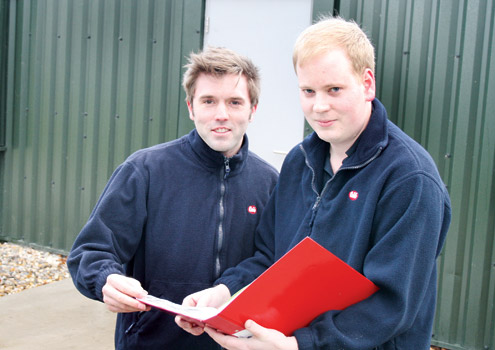Getting the most from broiler breeders

Managing breeding stock
Chick start
Start on house preparation well before the birds arrive, paying particular attention to the brooding period. The first 14 days of a chick’s life sets the precedent for good performance. Preheating the house is essential, ensuring adequate time to achieve the correct temperature, ideally 30-31C, with a minimum floor temperature of 28C. Check the chicks two hours after placement to ensure they are comfortable. On arrival the chicks should have good access to fresh feed and water, using supplementary drinkers for the first seven days.
16- to 24-week management
This is a critical period for ensuring the birds have a high degree of uniformity, and are the adequate weight and in the right condition for transfer to the production site. Female parents should achieve sufficient bodyweight gain between 16 and 20 weeks of age to maximise peak egg production and maintain post-peak persistency.
Broiler breeder hens come into lay in response to increases in the day length when made at the appropriate time. The response of the hens to light stimulation is based on their condition, bodyweight and age. Accurate weighing, good observation and handling is essential to determine when a bird is ready to respond to daylight increases. Delay light stimulation if the flock still contains significant numbers of underweight birds.
Male Management
It’s important to remember males make up 50% of the flock in achieving the maximum number of fertile hatching eggs. The objective is to produce and maintain quality males to ensure the highest levels of fertility. It’s essential to keep the feed and bodyweight continually increasing, but well under control.
A quality male will have an upright body shape, be active and alert, show good colour in the comb and vent, and not have too much or too little “fleshing”. Males in poor condition should be removed while maintaining the correct ratio.
Post-peak feeding management
Remember that the hen carries half of the genes responsible for broiler performance seen in her progeny. Females can become overweight post-peak, which may lead to problems with persistency of lay and fertility in the later stages of life. The key to controlling female bodyweight is to have a good understanding of each individual flock so you know when to decrease feed. Periodic handling of the hens, along with weighing, is necessary to determine subtle changes in body composition.
Don’t neglect the ‘basics’
Adequate clean water and quality feed, ventilation management, bodyweight control, hatching egg and litter management are the obvious essential components. Where a flock does not perform well, it often is simply down to neglecting some of these basics.
Management techniques are meaningless if the person responsible for the birds doesn’t have the correct skill set to get the most out of the flock.
Maintaining good flock health
Keep tight control on visitors
Make sure that strict biosecurity measures are followed. All gates to the farm should be locked, with instructions for any visitor to contact the site manager before entry. Make sure that all visitors have a genuine need to attend the site and that they sign a visitors’ book, stating the reason for their presence, and whether they have had contact with poultry in the past 72 hours.
Showering on to site
The best procedure is to provide a shower and change of clothing and boots for all visitors, as well as employees. At Cobb we insist everyone takes a shower for a timed five minutes before entering the farm.
Vehicles and equipment
Only essential vehicles and equipment should be permitted on farm. If vehicles have to enter, they should be thoroughly disinfected, paying close attention to the exterior, wheels, and wheel arches. Allowing tools and equipment on to the site should be minimised.
Make sure foot-dips are doing their job
Too often foot-dips are neglected, with the water becoming contaminated with leaves and soil. Ideally, use a covered foot-dip outside each house, measure the dilution rate accurately and change the solution every one to two days.
Guard against vermin and wild birds
Check baiting points for rats and mice every week, and make sure the housing is vermin proof – pay special attention to worn door seals, vents and drain holes. Keep the grass closely mown and avoid feed spills.
